The Top 10 Best Saws for Woodworking
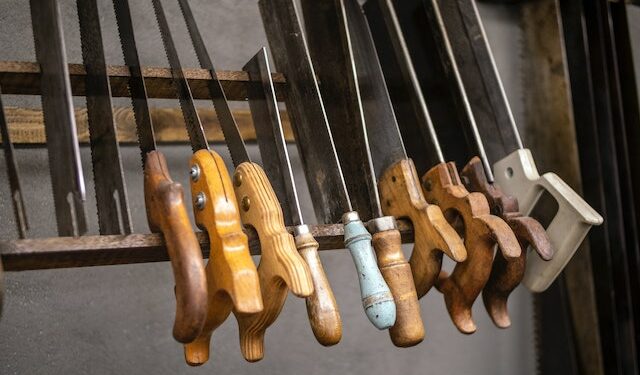
Woodworking requires a variety of tools, and the saw is one of the most essential. Whether you’re a beginner or a seasoned woodworker, choosing the right saw can make a big difference in the outcome of your project. With so many options available, it can be overwhelming to decide which saw to purchase. That’s why we’ve put together a list of the top 10 best saws for woodworking.
From handheld to stationary, each saw on this list is sure to provide the precision and power you need to tackle any project. So, whether you’re building a birdhouse or a custom dining table, read on to discover the perfect saw for your needs.
The Saw That Started It All – The Hand Saw
Oh yeah, the Hand Saw. We can’t forget about this little guy. This is the saw that started it all. Some folks may call it the “old reliables” or “dear old friend”; but no matter what you call it, the hand saw will always be the OG of saws.
You know how it works. It consists of two metal arms that are fastened together, one with a blade, and the other with a handle. The handle is what will give you more control over the saw, and the blade can be made from a variety of materials like carbon steel, high-speed steel, or chrome and nickel alloy. Back in the day, you could get all kinds of hand saws like rip saws, crosscuts, and backsaws as well.
You don’t see as many of these types of saws on the market lately, but the hand saw still has its advantages. For one, it is the most portable and lightweight option of the bunch. That makes it an ideal choice for most people, especially the do-it-yourself types, since it can easily fit into a backpack or toolbox.
On the flip side, hand saws are not as versatile as their modern counterparts. You won’t be able to cut through harder materials or make precise cuts with a hand saw. However, if you’re in a pinch and need to make a few cuts with a small saw, you can always count on the hand saw.
The hand saw may have started it all, but there are more sophisticated options out there for woodworking. Still, the hand saw is an invaluable tool, perfect for those quick cuts or when you don’t want to lug around bulky saws.
Features of the Hand Saw
Welcome to the world of woodworking! In this article, you’ll learn about the top 10 best saws for woodworking – from the saw that started it all – the hand saw – to reciprocating saws. Let’s start with the hand saw, one of the oldest saws used in woodworking!
First of all, the hand saw has a unique shape. It’s relatively long, with a handle at one end and a bevelled edge on the other. The handle gives you a good grip for precise, accurate sawing and the bevel ensures clean cuts without splinters. This makes the hand saw perfect for making straight and curved cuts in wood.
The blade of a hand saw is also very thin and precise, allowing for a smooth and seamless cut. This makes it ideal for sawing intricate shapes and curves as well as making precise straight lines. The hand saw also has more control over the depth of the cut, allowing for greater accuracy and a cleaner finish.
The hand saw is also very lightweight and easy to carry, making it ideal for on-the-go woodworking. The wide variety of shapes and sizes available also means that you can find the right saw for the job. Whether you need a long handled saw for bigger projects or a smaller saw for intricate cuts, there’s sure to be one that fits the bill.
The hand saw is a time-tested tool, and its utility has made it a staple of woodworking for centuries. The lightweight design, precise blade and good grip make it ideal for making intricate and precise cuts. So if you’re looking for a tool that will help you make beautiful and precise woodworking creations, the hand saw is definitely one to consider!
Advantages of a Hand Saw
Ahhhh the hand saw, that amazing equipment that started it all… a woodworker’s best friend and your next best tool if you’re looking for something for those small but tough jobs where accuracy isn’t a necessity, then you must get a hand saw. And if you sready have one, may I just say WOWEE!
A hand saw has some of the most amazing advantages that you can’t find on any other type of saw:
First of all, its autonomy is unrivaled – there’s no need to be plugged into an electrical source, so it can be used pretty much anywhere. Furthermore, it’s lightweight and and small, making it easy to transfer and store it and transport it on the go.
Second, as far accuracy is concerned, it’s generally easier to control and allows more delicate cutting, owing to its smaller size. This makes hand saws incredibly useful for cutting intricate patterns on wood.
Third, and this one’s for the eco-friendly woodworkers out there – a hand saw doesn’t need gas or electricity, so you won’t be contributing to pollution and global warming while using it.
And last but not least, the obvious – a hand saw is just so darn cute, you almost want to cuddle it! Just give that beautiful handle a pat and you’re ready to put it to work… can you say the same for those loud, scary power saws?
So for those of you who love saws, ya be prepared to be delighted by the advantages of a hand saw. And for those of you who are feeling adventurous and up for a challenge, go ahead and give a hand saw a go! You won’t regret it.
Table Saws
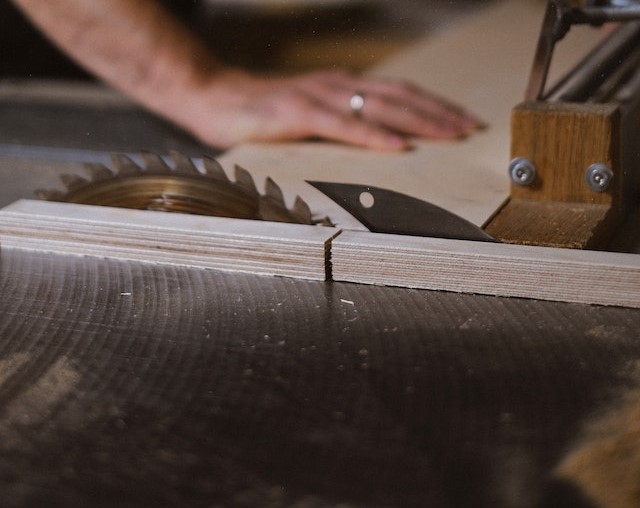
Once upon a time, there was no table saw. Everything was done with elbow grease and sweat. Engineers were having a difficult time cutting sheet material cross-grain with accuracy that was as good as sidewise cuts. But then, the heavenly table saw descended from the heavens to give mortals the power of precise, accurate cuts. The table saw luckily has been around for many years now, and it has been the most important tool in a woodworker’s arsenal.
Table saws usually measure around 3 feet in length, and they come in both stationary and portable models. The portable ones have a handle and wheel and are a bit lighter, while the stationary one is designed to be fixed to a flat surface. They all have a circular power saw tilted so that the blade is at waist height.
A table saw consists of a motor, blade, sawdust bag and table. The power motor provides the power to rotate the blade at a certain speed, usually at least 3,000 rotations per minute. The sawdust bag captures the shaving of the material being cut. The table is made of either steel or cast iron, and serves the purpose of providing a platform for cutting the material.
Table saws come in different types for different purposes. The most popular one is the hybrid table saw. It is versatile and can handle both soft and hard materials such as wood, laminate, and composites. Another type is the contractor table saw which is designed for contractors who need a saw that is versatile and powerful. It has a powerful motor and an extended fence system.
The benefits of owning a table saw are more than one can begin to imagine. Its portability allows it to be used anywhere and its adjustability enables the user to make accurate cuts. The blade can be used for a variety of cuts with ease, such as rips, cross cuts, miter cuts, dados, and tenons. Table saws allow for accurate and clean cuts which is arguably the most important benefit of all. Last but not least, it is easy to install and use, making it the ideal saw for both professionals and amateurs.
So now that you know all about table saws, go ahead and make the most of them. By heeding the advice of the heavenly table saw, you will be able to make precise cuts and make your woodworking projects look amazing. There’s no time to waste, so what are you waiting for? Get your workbench and get sawing, woodworker!
Different Types of Table Saws
Hey y’all, you wanna do some woodworkin’, you better know the different types of table saws before you get startin’.
First up, let’s talk about the standard table saw. This basic saw has a round blade that’s pushed through your wood piece by a motor. Most standard table saws have a rip fence, which is a long guide that helps you achieve a precise cut.
Next up, we got the contractor table saw. This saw is designed for the pros, with features that serious woodworkers need. This saw is bigger and heavier than the standard table saw and can handle larger pieces of wood and taller bits of timber. It normally has a smaller motor than the standard, but it’s still powerful enough to get the job done.
Then you got the hybrid table saw. It’s the little brother to the contractor saw, with a motor that’s between the standard and contractor saw in size. This makes it big enough for more precision, but small enough for portability.
Last, let’s talk about cabinet table saws. These are specifically designed for cabinetmakers and have features to make super precise cuts. Plus, they’re built with a lot of heavy-duty pieces, like a beefy trunnion and cast iron wings to help keep your cuts consistent. Some of these saws come with accessories, like a fence, miter gauge and guards.
So there you have it ladies and gentlemen, the different types of table saws. Now, you can make sure you’re usin’ the proper saw for the job before you start yer woodworkin’!
Benefits of Owning a Table Saw
Now if you need to saw some lumber, the all-powerful, masterful table saw is in a league of its own. While other saws take their sweet time cutting through wood, a table saw can make the job look easy. Plus, having one of these bad boys on your woodworking bench can save you loads of time and energy.
First and foremost, a table saw is extremely accurate, allowing for consistent and precise measurements. This is definitely a plus when you’re trying to build something symmetrical, or get really accurate cuts. Also, if you don’t have a lot of experience with other saws, the table saw is a great place to start. They normally have plenty of safety guards and features that make them safe to use.
A table saw is also great for creating large pieces of wood. No matter what you’re looking to make – shelves, a dresser, or just a big picture frame – the table saw has got you covered and will make short work of your project. With the help of a few accessories, you can even use it to finish your pieces and make them look like they were professionally done.
Plus, the table saw can cut any angle you’d like with precision. You don’t have to rely on a jig saw or hand saw to cut the angle you need, because the table saw can do it with ease. And if you have a long piece of wood, the table saw can handle it without breaking a sweat.
Finally, table saws can be used to create dovetails or other jointing options. This is especially helpful if you are making furniture, or any other project that requires hefty strength. Without a table saw, the process would take exponentially longer and the accuracy would be severely lacking.
All in all, a table saw is an essential item for anyone’s woodworking toolbox. The accuracy, safety, and convenience it offers are unrivaled, and it’ll save you loads of time and energy in the long run. So what are you waiting for? Get yourself a table saw and make yourself a master woodworker.
Jig Saws
Welcome to the wonderful world of jig saws! Now, I’m sure you are wondering what jig saws are and why you should use one. Well, jig saws are great tools used mainly for woodworking, as they can be used to make cuts of all shapes and sizes.
When it comes to woodworking, jig saws are very versatile. In addition to being able to cut in tight spots, they can also be used to make intricate shapes and patterns. With the right blade and a bit of practice, you can create some really neat pieces with the jig saw.
Jig saws are also great for making cuts in thin pieces of wood. By adjusting the blade depth, you can control how deep the cuts are and not have to worry about damaging the wood.
There are plenty of advantages to using a jig saw as well. The blades are relatively affordable and they come in a variety of materials and sizes. This allows you to find the perfect blade for whatever task you might be working on.
Another great benefit of jig saws is that they are relatively safe to use. With the right technique, you can easily cut through a piece of wood without having to be worried about the blade slipping or breaking.
Lastly, jig saws are incredibly lightweight and portable. Even with a variety of different blades, your jig saw can easily be moved from one job site to the next. With a jig saw, you can take on even the toughest woodworking projects!
So there you have it. I hope this overview of jig saws has been helpful and that you now feel more confident using one. Whether you’re a beginner or an experienced woodworker, jig saws can be an invaluable tool. So go ahead and give one a try – you just might be surprised at how much easier your projects can become with the help of a jig saw!
What are Jig Saws Used For?
Hey, so you wanna know what jig saws are used for? Well, if you’re into woodworking then they’re essential tools! A jig saw is a type of saw that’s used for cutting curved shapes and patterns in wood, plastic and metal. It has a thin, narrow blade that moves rapidly up and down in a reciprocating motion and is guided by an adjustable foot plate.
The jig saw is great for creating freehand circles and intricate curves. You can also use a jig saw to produce decorative notches and precision cuts, like in dovetails and dowel joints. It’s optimal for making intricate cuts in thin materials like plywood and wafer board.
But that’s not all a jig saw is good for. You can also use it to make plunge cuts, hass the blade in a board, trim door and window frames, cut wall plates in trim carpentry, cut out a patio in concrete and cut holes for electrical outlets and switch boxes.
Best of all, jig saws are relatively easy to use, so you don’t need to be a top-notch woodworker to get the job done. All you need to do is make sure the blade is lined up with the intended cut line and then gently press the saw’s power switch to turn it on and get to work!
At the end of the day, a jig saw is one of those essential tools that all woodworkers need in their arsenal. Whether you need to make intricate patterns, curves and circles or if you’re just doing some trim carpentry around the house, it’s a must-have tool that can make easy work out of even the toughest tile and woodworking projects!
Advantages of A Jig Saw
Ah Jig saws,my personal favourite. It’s like a puzzle piece waiting to be discovered. Jig saws can cut through just about anything, no matter how thick or thin – from leather to hardwood. You can use it on metals, woods, some plastics and even on composites. I mean, who doesn’t love a tool that can handle so much work?
Other than that, jig saws are also great for intricate cuts. You can use it to make straight cuts, curved cuts, and intricate designs. And since it’s a versatile tool, you don’t need to use too much power to get the job done. In addition to that, you can adjust the speed and the angle of the stroke to get the perfect design.
And of course there’s the added bonus that it can be used in tight and confined spaces. Where most tools can’t access, the jig saw will take you there in no time. This makes it ideal for small furniture projects that require precision and accuracy.
That’s not all; jig saws have no problem with dust or debris too. Because of its thinnish blade, the saw creates minimal dust and debris which you can easily clear after using the saw. And since the Speed of the jig saw is adjustable, low speed can be used for dust generation reduction.
Oh, let’s not forget about the portability factor. Most jig saws are pretty lightweight, so you can easily carry it around with you wherever you go. And most of them also have noiseless blades, so you won’t have to worry about disturbing your neighbours or ruining your own little sanctuary.
All in all, Jig saws are amazing tools that can cut through so many materials with ease and that can provide some amazing cuts. I’m sure you are all aware by now of all the benefits of owning a jig saw. So, pick one up and get those woodwork projects out of your head and into reality. Have fun!
Circular Saws
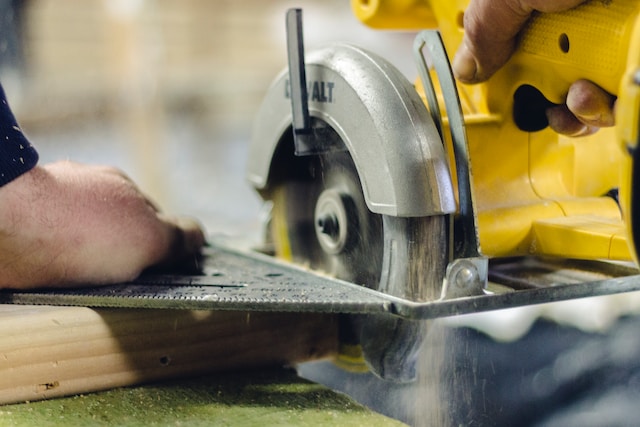
Greetings everybody and welcome to the next saw on our list of the top 10 best saws for woodworking. Today, we’re all about one of the most common and versatile saws out there: the circular saw. Now, typically you’d use this to make straight cuts and long cuts through lumber and other materials. What really sets a circular saw apart from other saws is that it’s portable. This saw can handle a variety of intricate tasks and has a lot of precision to it.
Speaking of precision, the main difference between a circular saw and it’s other saw brethren is the wheel-like blade. The wheel is perfect for cutting a variety of materials and the motorized blade can adjust its speed for a variety of different results. The blade is also really easy to take out, so you don’t have to worry about rushing and cutting too much wood, which is nice.
The uses for a circular saw are vast. You can use it to cut a variety of materials like wood, lumber, metal, plastic, and even stone and brick. You can also use it to make rip cuts, cross cuts, miter cuts, and plunge cuts. It’s really a great tool to have around the workshop or tool belt.
Now, a circular saw does have some pros and cons — like any saw — so here it goes. The biggest advantage for sure is the portability. This saw is super easy to take with you and use on the go and can easily cut through most materials. The biggest con, however, is that it’s a bit loud. There’s a lot of noise generated from this saw and it takes some getting used to.
The bottom line is that if you need to make precision cuts and want a saw that’s portable and easy to use, then a circular saw is the perfect tool for you. So, that’s all I got for the circular saw. Be sure to check out the rest of the saws on our list and happy woodworking!
Uses for a Circular Saw
Circular saws are some of the most versatile tools you’ll find in the toolshed. As their name implies, these saws have a circular-shaped blade powered by an electric motor. You can use them to make curved or circular cuts, cross cuts (cuts made in a single pass across the material you’re sawing), rip cuts (used to reduce the width of the material, either parallel or perpendicular to the grain), and in other more specialized applications.
If you’re looking for a saw to do a variety of different projects, a circular saw can be a great addition. Here are just a few of the possible uses for a circular saw.
Making Perfect Crosscuts – When it comes to cutting straight lines, there’s nothing quite like a circular saw. With the help of a straight-edge guide and a little practice, you can make perfectly measured and straight cuts on anything from wood planks to drywall.
Framing Wood – Building a frame for anything from a window frame to your newly constructed wooden shed can be a challenge. A circular saw can make the job much easier. Just make sure you’re cutting the wood with the grain to achieve the most reliable results.
Planing a Deck – Want to make sure the deck boards on your newly built deck are even? A circular saw is your friend here as well. Just make a few shallow cuts across the deck to remove any unevenness in the boards.
Cutting Plywood and Sheet Material – Plywood and sheet goods like particle board, medium-density fiberboard, hardboard and more are often used in projects. A circular saw can quickly make clean and even cuts through all of these materials with ease.
Trimming Doors – When you have to hang a door but it’s just slightly too big, use a circular saw to make a careful trim. Start with a sheet of plywood or other sheet material that’s the same thickness as the door and use it as a guide when cutting.
Mortising Doors – Certain types of doors, like pocket doors, require mortises (notch or recesses) in the door frame through which the sliding doors can pass. Use a circular saw to make these cuts.
As you can see, a circular saw is a tool you’ll find yourself reaching for over and over again for all kinds of projects. With a bit of practice, you’ll find you can use it to make almost any type of cuts imaginable. Add it to your toolbox and save yourself time and frustration.
Pros and Cons of a Circular Saw
When it comes to sawing, the circular saw is a tried and true way to get the job done. The circular saw is awesome because of its power. With a large cutting capacity and a powerful motor, they can cut through most materials with ease and accuracy. This makes them ideal for woodworking, cutting through plywood, laminates, and other large pieces of material. Its lightweight design and affordable price tag also make it a popular choice for DIYers.
On the other hand, circular saws have some major downsides too. They are not very accurate when making precise cuts, so precise construction work can be difficult. Another downside is the limited range of angles and depths that the saw can handle, so making angled or curved cuts is impossible. They also have short blade life and tend to get blunt quickly, so you may need to buy more blades or sharpen them regularly to make sure the saw performs optimally.
Given its power and price, however, the circular saw is a great tool for most types of woodworking. With the help of some of the best aftermarket blades, good safety habits, and a bit of patience, you’ll be able to get great results out of a circular saw – no matter which project you’re working on.
Compound Saws
Let’s have a look at compound saws. Compound saws are multipurpose and have the power to perform a variety of tasks from making precise cuts to drilling holes. They’re more powerful than traditional saws and come with a range of features.
So what sets a compound saw apart? Well for starters, a compound saw is going to be more versatile than your average saw. It comes with a levering arm that helps to make angled and beveled cuts. This makes it incredibly useful when you need to cut curves and intricate details. Most compound saws also come with a motor and guide rail that help to ensure accuracy.
Compound saws also typically have a better performance than your average saw. They’re capable of making precise and accurate cuts due to the motor and guide rail being attached. It’s able to reach higher speeds than regular saws which make it great for quick and precise cuts.
What are the pros of owning a compound saw? Apart from the performance advantage, compound saws also come with compact and lightweight designs. This makes them easy to maneuver and enables them to fit into tighter spaces.
Compound saws are also perfect for those who don’t have much space to work with. Most of the time, compound saws are battery powered which means you can carry them around with you wherever you go.
Another great benefit of using a compound saw is that they come with a range of blades and interchangeable parts. This gives you the flexibility to change the blade to suit your project needs and make sure that you are always prepared.
So why should you consider a compound saw? If you’re in need of a multipurpose tool that is precise, lightweight and easy to use, then compound saws are the way to go. They’re great for when you need to make angled or curved cuts and they come with enough power and speed to help you nail those projects.
What Sets a Compound Saw Apart?
Ahhh, the compound saw! It’s the type of saw I’d usually use to make a few adjustments. As I’m sure you know, a compound saw does overlap with a miter saw, circular saw and even a table saw. But what sets a compound saw apart?
Well, let me tell you. First of all, compound saws are incredibly versatile and can be used for cutting wood, concrete, and even metal. The adjustable head and guard are designed to be tilted to different angles while keeping the blade at the same height level. This allows you to make precision cuts with ease. Plus, the rotating head makes it extremely easy to switch between different cutting angles without being restricted.
That’s not all. This type of saw also features a complicated gearing system that is capable of cutting through different items at different speeds. You won’t need to worry about manually adjusting the speed for each cut. In addition to the adjustable head and gearing system, the compound saw also has a compound action that allows you to make crosscuts and miter cuts in one single set up.
It’s essentially like getting three different saws in one! All that you need to add are the blades of course, choosing from the various sizes available to do specific projects. But trust me, with this tool, you can get through light or heavy duty jobs with precision.
Overall, the compound saw stands out above the rest because of its simple adjustments, fast speed and its range of cutting abilities. As an added bonus, you can even find models that come with a built-in light to make accurate cuts in dark spots. Now that seems to be a solid deal!”
Pros of A Compound Saw
Are you looking for an efficient and powerful saw for any woodworking project? The compound saw is one of the most versatile saws and can help you get the job done! Let’s look at five pros of having a compound saw.
The first pro of a compound saw is that it is extremely versatile. This saw can cut through a variety of materials such as wood, plastic, composites and more. Furthermore, it can easily pivot to make bevel cuts and miter cuts with the greatest of ease.
Second, this saw can be used in a variety of situations. Whether you are a landscaper working in the outdoors, a carpenter in a workshop, or a handyman in the home, you can use the compound saw to get the job done.
Third, this saw is great for making curved cuts. With a compound saw, you can easily make round, circular, or curved cuts that are essential in some projects.
Fourth, this saw is incredibly strong and efficient. It can cut through thick materials with ease and can easily outlast other saws.
Finally, this saw is great for tight spaces. With its ergonomic design, it is perfect for jobs that require precision and accuracy. Moreover, it is easy to maneuver and has great visibility of the work area.
So, if you are looking for a great saw for woodworking, the compound saw is definitely one to consider. With its versatile design and strong construction, this saw is a great addition to any toolbox. Whether you are working on small or large projects, the compound saw will help you get the job done with the greatest of ease.
Band Saws
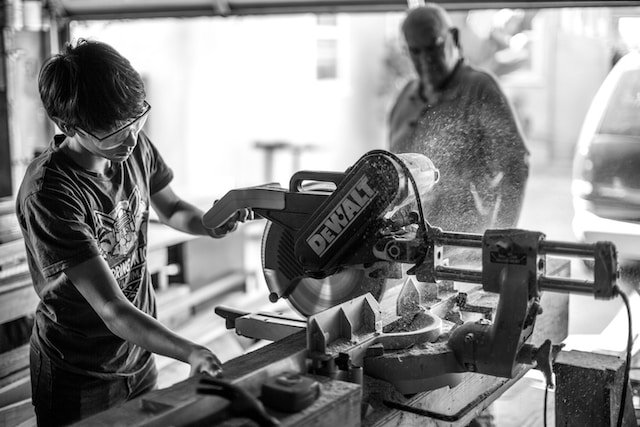
When you first hear the term “band saws”, you may start picturing a 70’s rock band or the latest boyband from Sweden. But I’m talking about the woodworking tool version of a band saw! It’s a type of saw that literally has a metal band running between two or more wheels as a saw blade. That’s right, it’s like a mini mosh pit inside your saw.
So, what are they used for? Band saws are incredibly versatile because they can make curved cuts, bevels, and any type of cut that requires a lot of precision and accuracy. They’re best suited for working with thin materials like plywood and laminates.
Now let’s talk benefits. Band saws offer a lot of control and precision, which is why its great for detailed projects like making curved shapes, scrolls, and other intricate pieces. And, another great thing about a band saw is that its blade size can be adjusted for different depths so that it can make deep cuts with ease.
So, now you know why people are so jazzed over band saws! They offer a lot of control and precision, making it easy to make detailed projects. And, their ability to make deep cuts with ease makes them a must-have for any woodworking enthusiast. So, don’t forget to buy one the next time you’re at the store!
Reasons to Use a Band Saw
If you’re a woodworker in need of some serious sawing power, then the band saw is the go-to saw for you. This saw uses a continuous steel blade and is best suited for cutting curves, making clean cuts of thick stock, and quickly cutting through thick lumber. This saw powers through and is capable of taking on work that would otherwise require a more expensive and expensive-to-maintain saw.
As an added bonus, the band saw is safer than most of the other type of saws because the blade’s teeth are outside of the work area. Even though the saw is powerful, the need for sharp blades after each use is minimal and you don’t have to worry about constantly sharpening the blade like you do with other common types of saws.
One of the key benefits of the band saw is the fact that it’s made to evenly and accurately cut curves, which can be difficult for other types of saws. If a woodworker wants to cut intricate carvings, then a band saw should be the first tool reach for because of its unmatched flexibility. Nothing can top the ability to get the job done faster and more precisely than a band saw.
And if you’re a woodworker who spends most of their time cutting curves, then a band saw can help lift some of the mundane tasks off of your shoulders. Since the band saw is made to curve cuts, a woodworker won’t have to worry about investing in other more expensive saws, like a jigsaw, which may not be necessary if curves are the primary focus.
So if you’re looking for a saw that can help make your projects much easier, then the band saw is the right choice for you. You can kiss mundane and hard to-do tasks goodbye and you’ll be able to tackle any project with style and ease. Your friends and family will be impressed with all the curves and intricate carvings you can do with this saw and you can do it faster than ever before. What are you waiting for? Go get yourself a band saw today!
Benefits of Using a Band Saw
When it comes to making perfect cutting angled cuts, nothing beats the accuracy and precision that you get from a band saw. This saw is specially designed to cut through a variety of different materials, and its main advantage is that it produces sawdust instead of chips and splinters. This makes it the saw choice for both woodworking and metalworking projects.
The size of the cuts made with a band saw are precise, so you can make precise cuts with ease and efficiency. You can make curved and intricate cuttings without fear of cutting crooked lines or having visible flaws in the finished product. Furthermore, you can also make bevel cuts simply by adjusting the blade angle.
When cutting thick materials, band saws are a must. You can quickly and easily slice through tough material like wood and metals. The smooth, continuous cuts that the saws offers makes it safer to work with larger pieces of wood. Plus, with the addition of a rip fence, you can always make sure that your cuts are straight and even.
The relatively thin blade used in the band saw allows for more consistent and accurate cuts as well. It’s easier to keep the blade from wandering, as well as it exerts less pressure on the material. On top of that, the blades require less maintenance and sharper blades don’t have to be switched out as often. And with the availability of band saw blades in different shapes, profiles and sizes, there’s always the right saw for any job.
Band saws can also save you time and money. With the saw, you can make multiple cuts at once, reducing the amount of time you need to spend sawing wood. On top of that, band saws are relatively affordable and also don’t require you to invest a lot of money in additional accessories.
Ultimately, a band saw is an essential tool to have in your wood shop. Whether you’re a professional woodworker or a hobbyist, a band saw can make the work of cutting wood a lot easier and more accurate. With the right blade, you can make precise cuts no matter what type of material you’re working on, saving you time and a lot of headaches.
Miter Saws
Ah yeah, miter saws. These are versatile tools a woodworker should definitely have in their arsenal! They make it so much easier to cut those precise angles that you need for those complex projects. Now what are the benefits of a miter saw?
Well it goes without saying that the miter saw is incredibly convenient for making accurate cuts for your woodworking projects. Sure, you could do it with other saws, but that means you’ve got to be real sure of your measurements and it can often be a hassle. It’s also way more efficient to just use the miter saw! With it, you can get exact and quick cuts without having to measure each cut individually.
There are also different types of miter saws that can fit a variety of needs. You can get ones that are powered electrically or have motorized blades. This is great for heavy usage since you don’t have to worry about sharpening blades all the time or being careful around them. Plus, you can get miter saws that are specific to the material you’re using!
In addition to the convenience, miter saws are also able to make cuts even when the object is awfully close to the cutting line. Sick of off angle cuts? Well you don’t have to with the miter saw! Most of them come with incredible precision and accuracy, which makes them great for those tight corners and top-notch finishing.
And if that wasn’t enough, miter saws can be adjusted to different angles, giving you the flexibility to work on more than one type of project. Now you can work on those furniture projects with ease, since you can just adjust the angle for different type of wood. You can also use miter saws for crown moldings and trimming or even just to cut multiple pieces of wood at once.
All in all, miter saws are a great addition to any woodworker’s toolbox. With all the benefits that come with it, there’s no doubt you’ll find yourself reaching for it more and more with each project!
Benefits of A Miter Saw
Me here talking about the ‘Top 10 Best Saws for Woodworking’. We’re approaching the seventh saw in our list today, the Miter Saw! It’s a classic saw that has been around for centuries and is perfect for doing precise angles.
So what are the amazing benefits of a Miter Saw? For starters, its accuracy is unmatched. It’s the most precise saw within the woodworking family. If you need accurate angles and cuts, then you should definitely look into a Miter Saw. It can cut angles like a pro and make sure that your cuts are consistent every time. It will always give you the desired results.
Another great benefit of a Miter Saw is that it’s incredibly easy to use. You can set it up and get cutting in no time. It can be a great addition to any woodworking shop and won’t take up too much space either.
You also don’t have to constantly stop and measure what angle you’re currently cutting at like you would with a jigsaw, which is nice. Just crank the knob, adjust the angle and start making your cuts. This can really save you a lot of time in the long run.
Finally, a Miter Saw can also be used to make crosscuts as well. Your board that runs along the saw will also act as a stopping point for you, making it easier to cut the same length of hardwood with ease.
And that’s it – seven out the top ten best saws for woodworking done! The Miter Saw is surely a great candidate to add to your woodworking arsenal and should definitely be considered. Now stay tuned for the next one!
Advantages of Owning a Miter Saw
It’s time to talk about the advantages of owning a miter saw. Now, I’ve had a few talks with some of my woodworking friends, and it seems like most of them agree that the miter saw is one of the best tools in the workshop.
First of all, having a miter saw gives you the ability to create accurate and precise angles for your woodworking projects. With the adjustable miter saw, you can make the exact angles you need for any job. Not only does this make it easier to create the exact angles that you need, but it also makes the job go much faster.
The miter saw is also a great tool for making cut-outs. You can make curved, intricate cuts with a miter saw, which simply can’t be done by hand. This makes it great for cutting out shapes and designs for more complex projects.
And if that weren’t enough, the miter saw is also great for making multiple cuts quickly and accurately. With the adjustable angles, you can make consistent and precise cuts without having to use a marking gauge.
Plus, one of the coolest features of the miter saw is the dust collection system. Most miter saws come with a dust collection port, which directs the dust and debris away from your work area. This helps keep your workshop clean, and it also keeps your breathing air free of dust.
To sum it up, if you’re serious about woodworking and want to save time and get accurate, precise cuts, then you need to own a miter saw. And yes, I know I gave you a hard time about it, but you know I’m just messing around. That thing is an absolute workhorse, and I know your woodworking will benefit from having one in your arsenal. Who knows, maybe you’ll end up shirtless like me, showing off those perfect miter saw cuts.
Scroll Saws

Hey, hey, hey! Are you a woodworker and curious what kind of saws you ought to be looking into? Well, one type of saw that you may likely need during your projects is the scroll saw.
So, what is the benefit of a scroll saw, you ask? Well, let me tell you. Scroll sawing is an art form, y’all! It’s used for small, detailed cuts that require precision. A scroll saw is meant for making intricate cuts and patterns with wood, from straight cuts to curved and curved. Examples of the cuts it can make are intricate patterns, circles, curves, and small openings. It can be used to cleanly separate small and thin pieces of wood.
Now, let’s go over some of the features of a scroll saw. It is a stationary machine which is composed of a small electric motor driving a reciprocating saw blade through a table. It usually runs on a 120-volt electric outlet. The size of the saw also varies, depending on what type of projects it is most suitable for. The blades on scroll saws come in a wide range of sizes, from 3 to 14.5 inches.
Scroll saws are a great choice for any woodworker or hobbyist, as they produce great results with little effort and very little noise. This is an important feature, especially for those in tight spaces, as a scroll saw will still produce great results without creating any additional noise.
Now, don’t worry if you don’t know exactly how to use a scroll saw (although you should get a basic understanding of its features). There are plenty of tutorials and videos out there that can help you get started.
I think it’s safe to say that a scroll saw can do a lot of things and is definitely worth considering if you’re a woodworker. With its intricate and detailed cutting capabilities, and its moderate noise levels, it has earned itself a well-deserved spot among the top 10 best saws for woodworking.
What is the Benefit of a Scroll Saw?
If you’ve ever watched those carpenter shows on TV, you know what a scroll saw is – that noisemaker that looks like a fancy jigsaw, but with a circular blade! It’s really the star of the show and it’s a must-have for any serious woodworker.
When it comes to cutting shapes and intricate designs in wood, nothing beats a scroll saw. A scroll saw has a small-toothed blade that helps you handle those delicate cuts that you can’t make with an ordinary saw. It’s a lot more precise than any other saw out there and if you’re looking for a fun way to expand your woodworking skills, a scroll saw is the way to go!
Scroll saws are surprisingly versatile and they’re great for making detailed, ornate designs. You won’t believe how much time you can save if you use one of these bad boys! You can quickly and safely make objects like keychains, dollhouses, wood statues or small furniture pieces. The possibilities are almost endless!
Scroll saws come in various sizes, so you can find one to match your needs – whether you want a large model for the workshops or a mini-model for those hard-to-reach spaces. And the best part is, scroll saws usually come with adjustable speeds and blades, so you can cut multiple types of material and make a variety of intricate shapes and designs.
So if you’re a serious woodworker, don’t wait to get a scroll saw – it’s a must for any workshop and you can make some really cool projects with it! And it’s really not as intimidating as it looks – with a little bit of practice and patience, you can master the art of scroll sawing in no time!
Features of a Scroll Saw
Hope you’re ready for the eighth installment of the best saws for woodworking segment. Speaking to the woodworking aficionados over here today, I’m sure you know a thing or two about scroll saws. Well, here is a feature rundown to make sure you get the whole picture.
Let’s start with the size. Scroll saws are relatively small, making them perfect for enthusiasts with small homes or studios. You can almost fit them into any tight space in your workshop and still make all the beautiful furniture or decorations you want.
Scroll saws feature a thin blade that is attached to an arm and connected to a motor. This means they can make delicate and intricate cuts that you won’t get with a regular saw.
Besides, you can customize the speed depending on the type of project you are working on. A scroll saw’s rotations-per-minute (RPM) can range from 400 to 1,700. The higher the RPM, the faster the blade will be able to cut through wood.
In terms of comfort and safety, scroll saws come with protective features, such as a transparent hood, integrated dust blower, and enclosed blade guard. The hood keeps the dust out of your face, which no one likes, and the guard is there to reduce the risk of injury, which is always a good thing.
The last feature I’m going to mention is the adjustable tilt table. Every scroll saw comes with a tilt table that allows you to tilt the blade up to 45°, which can come in handy when making bevel cuts.
There you have it, guys! Scroll saws are perfect for working on delicate projects, and they can definitely help you up your woodworking skills.
Chop Saws
Today we’re going to talk about the humble chop saw. They’re super handy in the woodworking shop, but they’re not something you may know a ton about.
Let’s dive right in, shall we? The “what” of chop saws is relatively simple: they’re a power tool used to make straight cuts in wood, steel, aluminum, and other materials. The “how” is a bit more complicated.
Chop saws are typically composed of two main parts: a stationary base and an arm that moves along an axis of rotation. The arm is typically connected to a disc composed of metal or diamond abrasives that helps with the cutting process.
Now, what is the benefit of using a chop saw? Well, they’re great for making quick, precise cuts in wood with minimal effort. That makes them great for skills like carpentry and other types of woodworking.
In addition to creating straight cuts, you can also use a chop saw to make correct angles in your work. This makes them ideal for creating cuts for furniture and other projects that require specific angles.
Plus, chop saws are usually flexible. Some models come with adjustable blades that allow you to switch between cutting materials like metal and wood.
Speaking of safety, chop saws usually come with safety features that help protect the user from injury. These include a hand guard to help keep your hands away from the saw and a spark shield to help keep the saw from producing sparks.
So there you have it: mobile, flexible, and easy to use with plenty of safety features, the chop saw is an essential tool in any woodworker’s toolbox.
That’s it for today’s topic, but stay tuned for more woodworking tips and tricks.
What Does a Chop Saw Do?
Ahhh the chop saw. What would a woodworking shop be without it? A lot less efficient, I can tell you that. A Chop Saw is a large saw with a power-driven circular blade that can cut through different materials like metal, wood, plastic and even ceramic tile. You can even adjust the blade to make angled cuts and a couple of other cuts – like bevel and straight cuts.
Now, there are two main types of chop saws, you’ve got the stationary chop saws and the portable chop saws. As the name implies, the stationary ones are bolted down to the workbench and can handle more materials as compared to the portable ones. The portable chop saws make it easier to move around, which is great for those working on sites far away from the workshop.
This big, bad saw can do a lot to lighten your workload, so let’s take a few things one step further. Now that you know what chop saws can do, you may want to know what they aren’t good for. I gotcha covered. Chop saws are not suited to precision cutting of the thinnest steel or even the softest timber. So, if you’re looking to get extremely detailed work from a power saw, then give your chop saw a miss.
But with its immense power, there’s no doubt that the chop saw is a great tool for the job. Aside from the straight and angle cuts it can make, the chop saw is also able to handle heavier materials than most saws, making it great for big jobs. As well as being a beneficial tool for hobbyists and professionals alike, this saw is also terrific for DIYers looking to save time.
So, if you want a saw that’s easy to use, versatile and powerful, then get yourself a chop saw – the perfect saw to help you get through the toughest of materials. You won’t regret it.
Benefits of Owning a Chop Saw
Ahhh, the chop saw! Once you get a taste for this bad boy, you’ll never go back. This handy saw is a must-have for any serious woodworking projects.
First and foremost, it’s powerful. This is due to its large motor and tungsten carbide-tipped blade, which can tackle even the most difficult cuts. Plus, with its fast-acting cutting capabilities, you can get even the toughest projects done in no time.
Second, it’s accurate. This saw is designed to precision, allowing you to make uniform cuts without any hassle. With its laser-guided accuracy and adjustable miter angles, your woodworking pieces will look like a work of art.
Third, it’s versatile. With its expandable table and adjustable blade guards, you can handle just about any type of cutting job. Whether you need to chop, shear, shape, or miter, the chop saw is your go-to tool for the job.
Not to mention, it’s a safe tool to use. The built-in guard and power switch lock allows you to preserve your beautiful digits. Plus, the blade is fully enclosed, so you won’t have to worry about any flying debris.
So, whether you’re cutting some crown molding for cabinets or just a few pieces of wood for a small project, the chop saw is a must-have tool to ensure a perfect cut every time. Yup, it’s one saw no woodworker should be without!
Reciprocating Saws
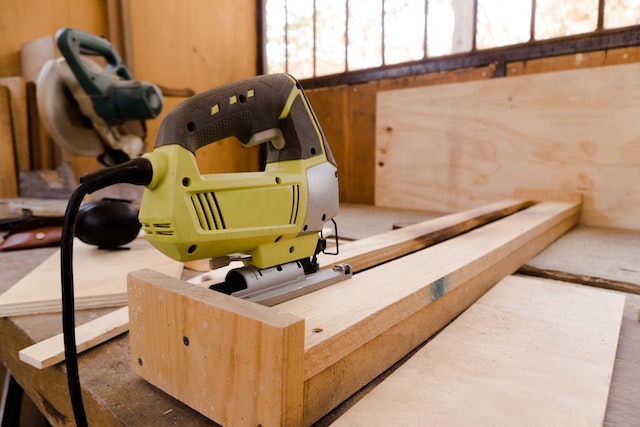
Ladies and gentlemen, are you looking for the best saw to add to your woodworking arsenal? If so, then you may want to take a serious look at the reciprocating saw. Yes, the saw that’s said to be able to cut through anything.
This powerful tool has been around for quite a while, and it has become indispensable for any serious woodworker. So, let’s take a look at what a reciprocating saw can do for you and why you need it for your woodworking projects.
So, what is a reciprocating saw? It’s basically a saw with a slender blade that moves in and out, like a back and forth motion. The motion is controlled by a motor and most come with variable speeds. It’s often used for demolition, for electrical work, for plumbing work, for automotive work and for woodworking. In other words, it’s an all-purpose saw.
Now, what are the benefits of using a reciprocating saw? Well first of all, it has the power to cut through materials that no other saw can, such as nails, screws, plastic pipes, and other difficult materials. There are also a wide range of blades available for reciprocating saws, including straight blades, curved blades and blades specifically designed for cutting certain materials. This makes it versatile and allows you to tackle a wide range of different jobs.
Another great feature of the reciprocating saw is that it is lightweight and easy to maneuver. It’s relatively small size when compared to other saws, makes it portable and easy to store. It’s also user-friendly and most come with variable speeds, which makes it suitable for use by both experienced woodworkers and beginners.
So, if you’re looking for a saw to do some heavy-duty work, then you should definitely look into a reciprocating saw. It has the power to cut through a range of different materials, comes in a variety of sizes and you can find blades to suit your specific needs. Plus, it’s lightweight, easy to maneuver and some come with variable speeds. All of these factors make it the perfect saw for any woodworking project.
What are They Used For?
If you’re a woodworker, then you’ve probably heard of reciprocating saws. I mean, who hasn’t? It’s the fastest, strongest, and most versatile saw. But you’re probably wondering, “What are these things used for?”
Reciprocating saws are the go-to tool for cutting through materials like wood, metal, plastic, and more. You can even use them to cut through thick roots and branches. With the right blade, you can use them to shape and trim metals, like machine screws and rebar.
You can see why these are popular in woodworking. The blades vibrate back and forth in a way that allows for a faster cut. And it’s all done with less effort. Plus, you don’t need to use a lot of force to control the saw.
These are also great for cutting pipes and tubes. These saws can make quick work of ripping through PVC pipe and metal tubes without leaving any jagged edges. Plus, they stay cool to the touch. The blades never get hot and the saw stays steady, so you can get precise cuts.
Reciprocating saws are also great for making those precise, fine cuts that you can’t get with conventional saws. With the right blade, you can make shapes and curves that you’d never be able to make with another saw.
So whether you’re a homeowner looking to tackle a DIY project or a pro who needs to get the job done quickly, reciprocating saws are the way to go. They’re versatile, fast, and powerful, so you can rest assured knowing you’re getting a precise, clean cut. And that’s why you should get yourself one of these today.
Advantages of Using a Reciprocating Saw
Well if you haven’t already figured it out, the reciprocating saw is one of the most versatile tools around. It’s great for cutting through just about any material you can think of, and it makes short work of jobs that used to take ages. Here are just a few of the advantages of owning a reciprocating saw.
The first major advantage is how quickly you can complete a job. Whether you’re cutting through metal pipes or wood boards, the reciprocating saw can get it done in a fraction of the time. This is especially beneficial when you’re on a tight deadline and need to get a project finished quickly. Plus, you’ll also save money in the long run because you won’t have to pay more money to hire someone else to do the job.
Another great advantage of a reciprocating saw is that it’s easy to use. Thanks to its lightweight design, you won’t have to worry about straining your back or arms while using the saw. And since it’s cordless, you don’t have to worry about finding an outlet to plug it into. This makes it perfect for use on the job or at home.
The final major advantage is accuracy. By utilizing the proper saw blades and settings, you’ll be able to make precision cuts with ease. This is especially important when it comes to projects that need precise measurements and cuts, like furniture building.
All in all, a reciprocating saw is a great tool to have around. It’s perfect for someone who needs to cut through thicker materials quickly and efficiently. Whether you’re a professional or a hobbyist, it’s definitely worth investing in one of these tools.






